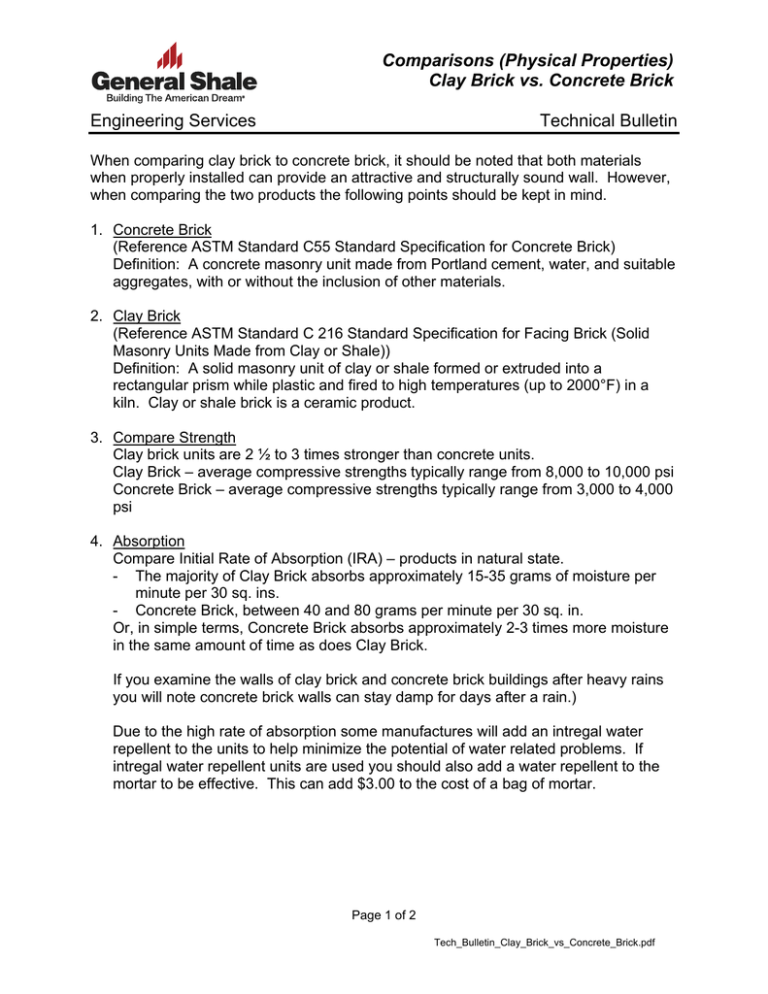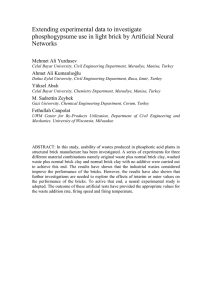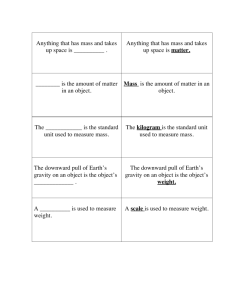Clay Brick vs. Concrete Brick.
advertisement

Comparisons (Physical Properties) Clay Brick vs. Concrete Brick Engineering Services Technical Bulletin When comparing clay brick to concrete brick, it should be noted that both materials when properly installed can provide an attractive and structurally sound wall. However, when comparing the two products the following points should be kept in mind. 1. Concrete Brick (Reference ASTM Standard C55 Standard Specification for Concrete Brick) Definition: A concrete masonry unit made from Portland cement, water, and suitable aggregates, with or without the inclusion of other materials. 2. Clay Brick (Reference ASTM Standard C 216 Standard Specification for Facing Brick (Solid Masonry Units Made from Clay or Shale)) Definition: A solid masonry unit of clay or shale formed or extruded into a rectangular prism while plastic and fired to high temperatures (up to 2000°F) in a kiln. Clay or shale brick is a ceramic product. 3. Compare Strength Clay brick units are 2 ½ to 3 times stronger than concrete units. Clay Brick – average compressive strengths typically range from 8,000 to 10,000 psi Concrete Brick – average compressive strengths typically range from 3,000 to 4,000 psi 4. Absorption Compare Initial Rate of Absorption (IRA) – products in natural state. - The majority of Clay Brick absorbs approximately 15-35 grams of moisture per minute per 30 sq. ins. - Concrete Brick, between 40 and 80 grams per minute per 30 sq. in. Or, in simple terms, Concrete Brick absorbs approximately 2-3 times more moisture in the same amount of time as does Clay Brick. If you examine the walls of clay brick and concrete brick buildings after heavy rains you will note concrete brick walls can stay damp for days after a rain.) Due to the high rate of absorption some manufactures will add an intregal water repellent to the units to help minimize the potential of water related problems. If intregal water repellent units are used you should also add a water repellent to the mortar to be effective. This can add $3.00 to the cost of a bag of mortar. Page 1 of 2 Tech_Bulletin_Clay_Brick_vs_Concrete_Brick.pdf 5. Movement Joints Most building materials exhibit some type of movement with changing weather conditions (temperature and humidity). And all building designs should account for this movement. Once put in service a clay unit will expand over time whereas a concrete unit will shrink. Clay units – Clay brick homes have been built for years without the use of movement joints. Unless your home is unusually large this is still a good rule of thumb. However, you should accommodate for expansion around all door and window openings. (provide a 3/8” joint and fill with flexible caulk sealant). Concrete units – Because of the nature of shrinkage movement concrete brick homes may be more susceptible to cracking. Because of this, joint reinforcing steel is required with concrete units to help minimize cracking due to shrinkage. Consideration should also be given to providing vertical control joints in the walls. The design of these joints should consider the aesthetics, water permeance, and maintenance of the joint. 6. Material Cost Depending on geographical location the following are typical price ranges (not including labor, mortar, or mortar additives) Clay Brick $230.00 - $300.00 / per thousand Concrete Brick $190.00 – $250.00 / per thousand 7. Labor Factors Certain concrete brick units (i.e. frogged) are sometimes difficult to cut cleanly using a trowel or brick hammer. This may require saw-cutting the units. Other factors such as the ease of cleaning the units might also effect labor cost. You should consult with your mason contractor to obtain a labor cost for either clay or concrete bricks. 8. Color and Texture Both clay and concrete brick come in a wide variety of colors. Certain textures such as a tudor effect is only available with clay bricks. You should view sample panels to make a selection regarding color and texture. However you should be aware that concrete brick are not color fast and they will fade over time. Page 2 of 2 Tech_Bulletin_Clay_Brick_vs_Concrete_Brick.pdf




